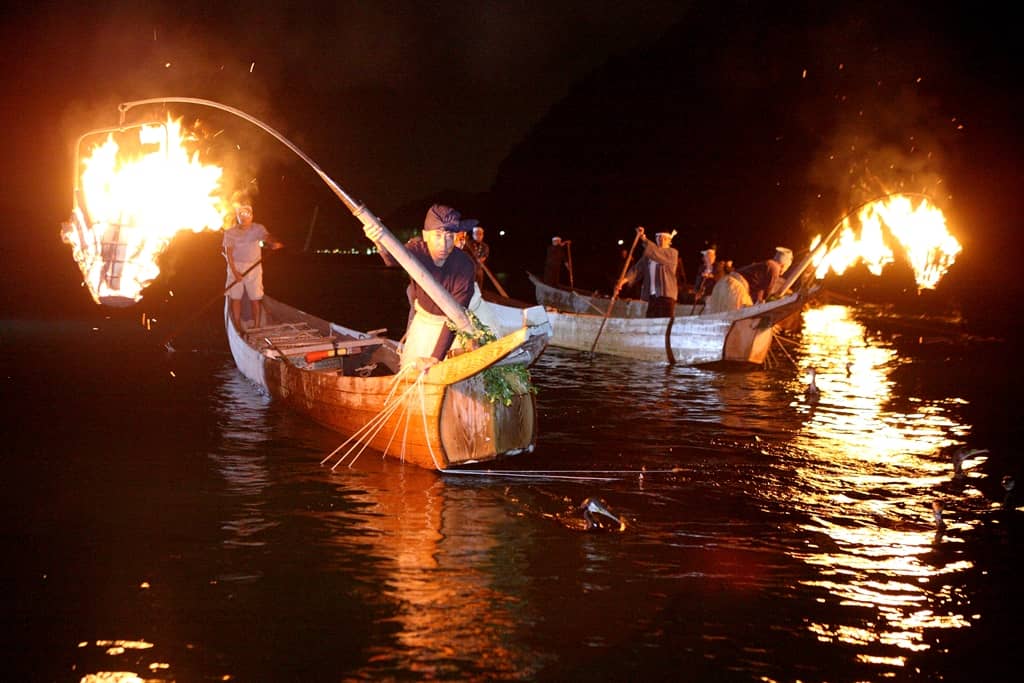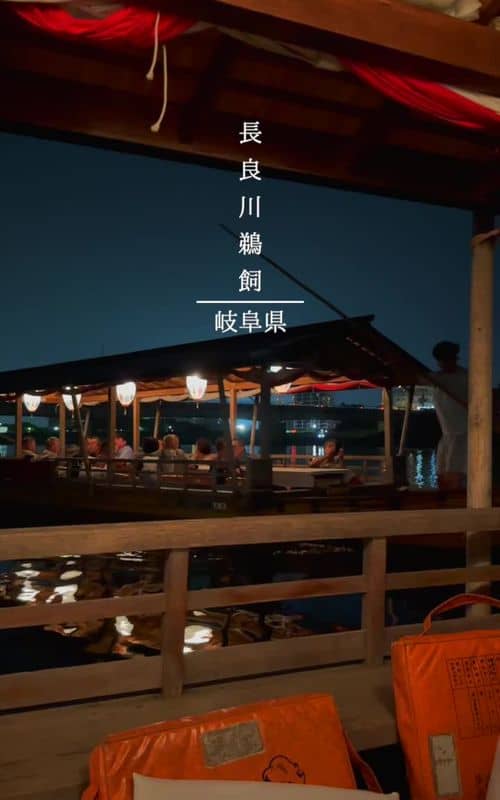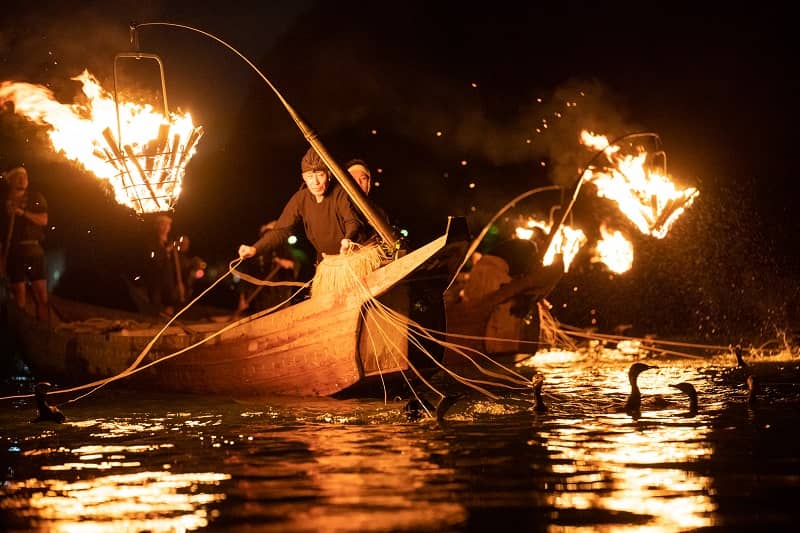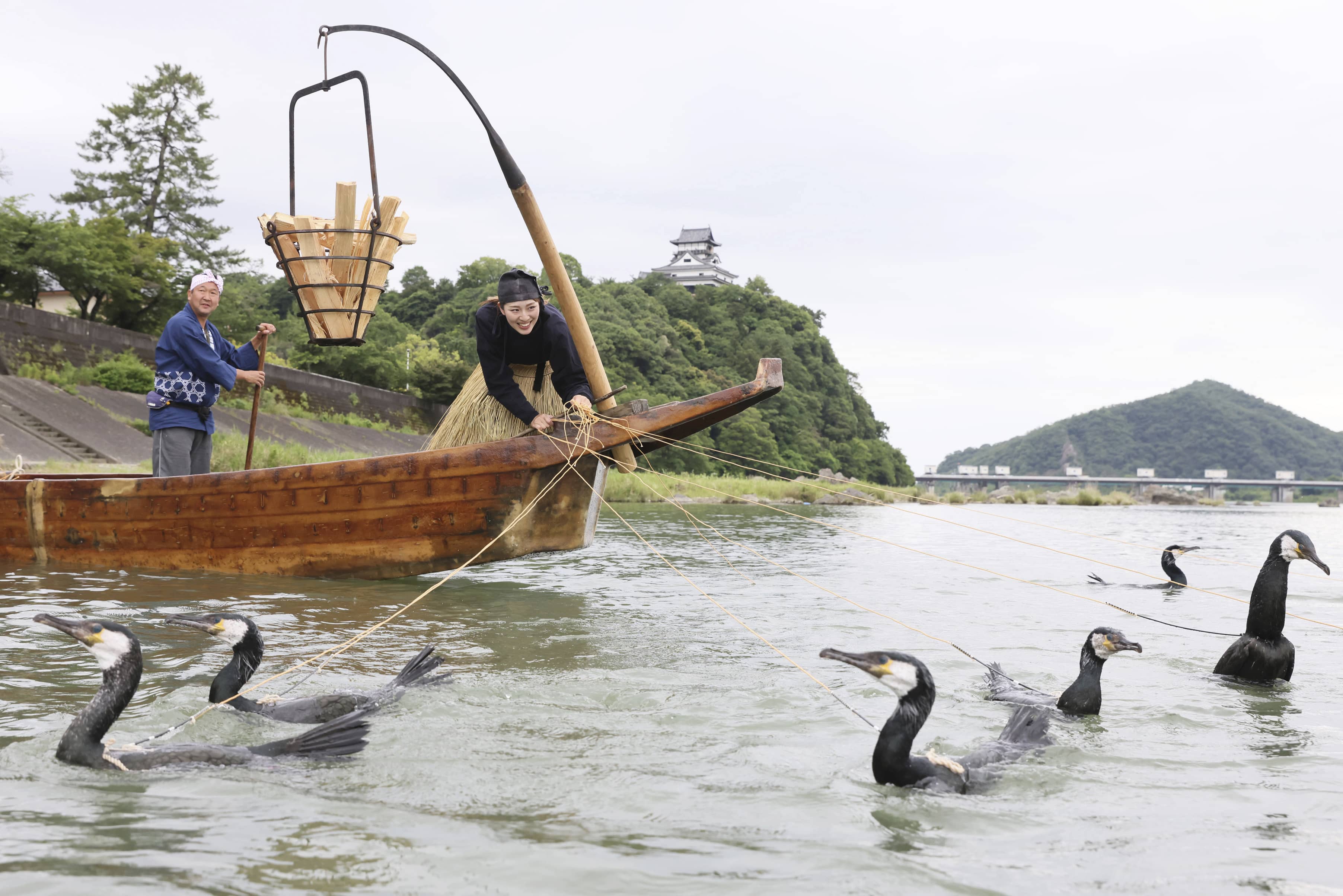Nagara River Cormorant Fishing
Witness a 1300-year-old Japanese tradition: fishermen use trained cormorants to catch fish under torchlight on the Nagara River.

Highlights
Must-see attractions

Social
From TikTok & Reddit
Best Time
The traditional fishing season.
Nagara River Cormorant Fishing
Best Time
The traditional fishing season.

Highlights
Must-see attractions
Witness a 1300-year-old Japanese tradition: fishermen use trained cormorants to catch fish under torchlight on the Nagara River.
"A truly unique and enjoyable experience, though booking can be a challenge."
🎟️ Book Observation Boat Tickets
Secure your spot on the observation boat via the official website well in advance.
🌅 Early Boat for Sunset Views
Opt for an earlier boat time to enjoy the sunset before the fishing begins.
Highlights
Discover the most iconic attractions and experiences

The Ukai Spectacle
Nagara River
Witness a 1300-year-old tradition of fishermen using trained cormorants to catch fish under torchlight.

Nighttime River Cruise
Observation Boats
Enjoy a serene boat ride on the Nagara River, illuminated by the glow of fire lanterns.

Ayu Fish Display
Observation Boats
See the ayu (sweet fish) caught by the skilled cormorants, a testament to this ancient fishing method.
Plans like a pro.
Thinks like you
Planning Your Visit
Book Your Tickets in Advance
Timing is Key for the Best View
Best Times
Insider Tips
from TikTok, Instagram & Reddit
🎟️ Book Observation Boat Tickets
Secure your spot on the observation boat via the official website well in advance.
🌅 Early Boat for Sunset Views
Opt for an earlier boat time to enjoy the sunset before the fishing begins.
🧥 Dress in Layers
Evenings on the river can be cool, so bring a jacket or sweater.
🥂 Bring Your Own Drinks
You can bring food and drinks aboard the observation boats.
Tips
from all over the internet
🎟️ Book Observation Boat Tickets
Secure your spot on the observation boat via the official website well in advance.
🌅 Early Boat for Sunset Views
Opt for an earlier boat time to enjoy the sunset before the fishing begins.
🧥 Dress in Layers
Evenings on the river can be cool, so bring a jacket or sweater.
🥂 Bring Your Own Drinks
You can bring food and drinks aboard the observation boats.
📸 Capture the Magic
The torchlight and boats create a unique, photogenic scene.
What Travellers Say
Reviews Summary
Visitors praise the Nagara River Cormorant Fishing as a unique and captivating cultural spectacle, highlighting the ancient tradition and the mesmerizing nighttime boat ride. However, some have found the online booking process challenging and noted that the viewing experience from the boat can sometimes be obstructed, leading to disappointment for a once-in-a-lifetime event.
"We did this as a "day" trip from Tokyo to Gifu. Sharing our experience to help others who may want to do something off the beaten track.
First you have to check this website for the cormorant fishing schedule: https://www.ukai-gifucity.jp/
Then, sign up as a member in the same website. You will receive an email on your membership registration. Click the link in this email to confirm your registration. You will receive a second email that says your registration is successful.
Go to the same website and select the date and time for cormorant fishing observation tickets. You need to sign in as a member at this stage and remember to log in using the same email address you entered during membership registration. If you are unable to log in, it could be your email address which seems to be Cap sensitive. Try keying in you email address with the first letter capitalised (because at the member registration web page, your email address is defaulted to capitalised first letter). Once you have successfully logged in, pay for the tickets. You will receive an email with a qr code for your successful ticket reservation.
To go Gifu from Tokyo, go to JR ticket office and buy shinkansen ticket to nagoya and jr rail ticket from nagoya to JR Gifu station.
Then walk to gifu bus station and board bus. Alight at nagarabashi, walk to the cormorant fishing observation boat office and present your QR code in exchange for the boat ticket.
Assemble 15minutes before boarding time and enjoy the boat ride and watch the cormorant fishing skillfully done by the usho controlling about 12 cormorants. There was fireworks and a boat with graceful Japanese dancers.
We were shown the ayu (sweet fish) caught by the cormorants."
Bake Swee Swee
"I reserve this course and expect a nice experience. But tonight (7/27) I got on the boat “Yugao Maru” and choose the right side of the boat. You claim that we can observe the fishing boat in a close distance, but all I saw is people’s head on the left side of the boat. This is truely frustrating. You should really improve the quality of this course. Especially for a foreigner this may be a once-in-a-lifetime experience. For me it’s very terrible one."
Mark Chang
"We didn't originally intend to do the cormorant fishing tour, but our Ryokan had a river view and it looked like so much fun, so we decided to check it out the next night. It was such a unique and enjoyable expereince.
We did the early boat, 18:30, so we brought food and drink aboard and were able to catch the sunset while we waited for the other, later boats to arrive. It wasn't explained well, but basically all the different boat times still see the cormorant fishing at the same time once it gets dark. The earlier boats just have more time on the water before and you are able to leisurely eat while waiting for the event to take place.
The cormorant fishing itself was both bizarre, slightly cruel to the birds, yet mystefying because it is a nearly 1000 year old tradition that has been ongoing in this region. I'm really glad I got to witness it because there was a genuineness to the ritual of this very unique fishing method.
Our only complaint was that it was bit of a challenge for us to book the time using their website."
anthony scott
What People Like
What People Dislike
Frequently Asked Questions
🚇 🗺️ Getting There
From Tokyo, take the Shinkansen to Nagoya, then a JR train to JR Gifu Station. From Gifu Station, walk to the Gifu Bus Station and take a bus to the Nagarabashi stop. The observation boat office is a short walk from there.
Public transport like buses is convenient for reaching the Nagara River from Gifu Station. Walking is also feasible from the bus stop.
Follow signs for Nagarabashi bridge and the cormorant fishing observation boat office. The area is well-signposted.
While driving is possible, public transport is often recommended due to potential parking challenges and the ease of accessing the observation boats.
Yes, some breweries like Yamakawa Jozo are near the fishing grounds, offering a chance to visit before or after the event.
🎫 🎫 Tickets & Entry
Tickets must be booked online through the official cormorant fishing website. You'll need to register as a member first.
The season typically runs from May 11th to October 15th each year.
Fishing takes place nightly during the season, starting after dusk. Observation boat times vary, with earlier slots available.
It's highly recommended to book in advance online, as tickets can sell out, especially during peak season.
Ticket prices vary, but booking online will provide the exact cost for your chosen date and time.
🎫 🧭 Onsite Experience
While some claim the right side offers a closer view, experiences vary, and crowds can obstruct the view. It's best to arrive early for your boarding time.
Some English information may be available on the website and at the venue, but there is typically no English translation on the boats themselves.
You'll witness fishermen (Usho) guiding trained cormorants to catch ayu fish, illuminated by torches on the water.
Sometimes, there are fireworks or boats with Japanese dancers as part of the evening's entertainment.
Yes, it's a unique cultural experience that can be fascinating for all ages, though the concept of using birds for fishing might require some explanation.
📸 📸 Photography
A tripod is recommended for low-light conditions. Consider a lens with a wide aperture for better performance in the dark.
Yes, photography is allowed from the observation boats, but be mindful of other passengers and use appropriate settings for low light.
Capturing the illuminated boats, the cormorants in action, and the reflections on the water are popular subjects.
The birds are fast, and the lighting can be challenging. Patience and a good zoom lens can help capture clear shots.
Generally, there are no specific restrictions, but always be respectful of other visitors and the performers.
For Different Travelers
Tailored advice for your travel style
👨👩👧 Families with Kids
📸 Photography Enthusiasts
✈️ International Travelers
Deep Dives
In-depth insights and expert knowledge
The Ancient Art of Ukai
The demonstration takes place at night, with the boats illuminated by flickering torches. This dramatic lighting not only attracts the fish but also creates a mesmerizing spectacle for observers. The Ushō expertly control their cormorants, guiding them to dive into the water and catch the fish. The cormorants are fitted with a special ring that prevents them from swallowing the fish whole, allowing the fishermen to retrieve their catch.
While the practice is visually stunning and culturally significant, some viewers have noted that it can appear 'slightly cruel' to the birds. However, it remains a vital tradition, with a few families continuing to practice it as fishermen for the imperial household, preserving this unique aspect of Japanese heritage.
Planning Your Cormorant Fishing Experience
Travelers often make a day trip from Tokyo to Gifu. The journey involves taking the Shinkansen to Nagoya and then a local JR train to Gifu Station. From there, a bus to the Nagarabashi stop will bring you close to the observation boat departure point. It's advisable to arrive at the boarding area at least 15 minutes before your scheduled departure time.
Once on the observation boat, you can enjoy the river cruise, often with the option to bring your own food and drinks. While the main event is the cormorant fishing, some tours may also include fireworks or performances by Japanese dancers, adding to the festive atmosphere. Be prepared for a unique cultural immersion, though English explanations on the boat itself might be limited.

Social
from TikTok, Instagram & Reddit